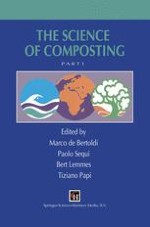1996 | OriginalPaper | Chapter
Impact of Composting Type on Composts Organic Matter Characteristics
Authors : Claire Serra-Wittling, Enrique Barriuso, Sabine Houot
Published in: The Science of Composting
Publisher: Springer Netherlands
Included in: Professional Book Archive
Activate our intelligent search to find suitable subject content or patents.
Select sections of text to find matching patents with Artificial Intelligence. powered by
Select sections of text to find additional relevant content using AI-assisted search. powered by
Three MSW-composts (C1, C2 and LC2) originating from separately collected organic household wastes were studied. C1 and C2 had undergone a traditional windrow composting with different maturation times. LC2 was a lumbricompost: the first 2 months of maturation had been replaced by an earthworm digestion. Composts organic matter was characterized at different levels. (1) Global carbon and nitrogen balances were determined in water or alkaline extracts and in acid hydrolysates. (2) Gross chemical fractionation was performed to estimate organic compounds like fats, resins, water soluble compounds, hemicellulose, cellulose, proteins and ‘lignin-humus’. (3) Biomolecules were more precisely analyzed with colorimetric methods: carbohydrates, amino acids and phenols. Some of the phenolic compounds were identified by HPLC. Organic matter characteristics were related to the degradability of the composts, assessed by carbon mineralization. In all the composts, a labile pool of organic matter could be characterized, as well as an important humified fraction. It appeared that maturation time (7 or 3 months) and lumbricomposting few influenced the studied organic matter properties.
